#Ayodhya Dispute
Explore tagged Tumblr posts
Text
What a resemblance
The rise of Hitler and the establishment of his dictatorial regime in Germany is a complex story rooted in the aftermath of World War I, economic turmoil, political instability, and societal discontent. Hitler capitalized on these factors to gain power and impose his authoritarian rule. Post-World War I Germany: After Germany’s defeat in World War I, the Treaty of Versailles imposed harsh…

View On WordPress
#2nd class citizens#A Gesture is Enough for a Wise Man#Abrogation of Article 370#Abusing Social Media&039;s#Accountability of Investigative Agency&039;s#Anti CAA#ANTI CAA PROTEST#Apex Court#Ayodhya dispute#Baba Ki Buldozer#BJP#black money#Blogging#Buldozer politics#Burning Issue in India#CAA#CASTE DISCRIMINATION#Chief Justice Of India#Citizens of India#Communalism#Controlled Democracy#Delhi Police#Delhi Riots 2020#DEMOCRACY#Devout Intolerance#Divide & Rule#Enforcement Directorate#Freedom of Speech#Global reputation#Godi Medias
1 note
·
View note
Text
#Ram Lalla#Ram Mandir#Ayodhya#Lord Ram#Hinduism#Divine Child#Spirituality#Temple Construction#FaithIn Ram#Cultural Heritage#Religious Harmony#Pilgrimage#SacredIdol#Ramayana#Divine Blessings#Ayodhya Land Dispute#Supreme Court Verdict#Hindu Tradition#Religious Unity
0 notes
Text
The Magnificent Ram Mandir and the Indian Democracy
There is something extraordinary about India. One such occasion—there are far too many—was the inauguration of the Ram Mandir on January 22, 2024. Well, you might wonder what makes it so unique. The commotion surrounding the occasion was rather unusual. At the function, the leader of the right-wing cadre-based organisation, the Rashtriya Swayamsevak Sangh (RSS), known for its open antagonism…
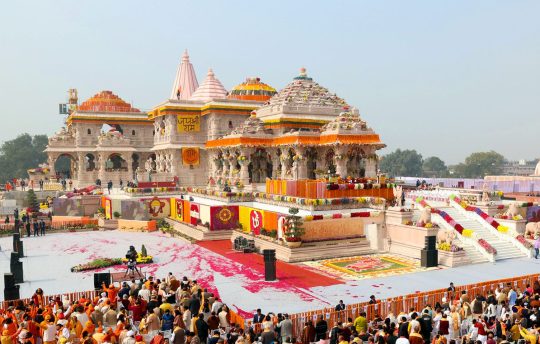
View On WordPress
#Ayodhya dispute history#history of demolition of babri masjid#Indian and their obsessions with temples#ram mandir#ram mandir and its implications on democracy in india#ram temple in ayodhya#temples in india
0 notes
Text
hindutva are celebrating the construction of a temple today (22.01.24) in ayodhya, uttar pradesh on the ruins of babri masjid, a mosque they destroyed in 1992. one of the common disputes around it is the existence of a temple before the masjid. the most extreme hindu nationalists don’t care either way because they just want mosques destroyed. the more liberal types dig up ‘proof’ of temple remains as if that justifies the violence muslims are facing centuries later.
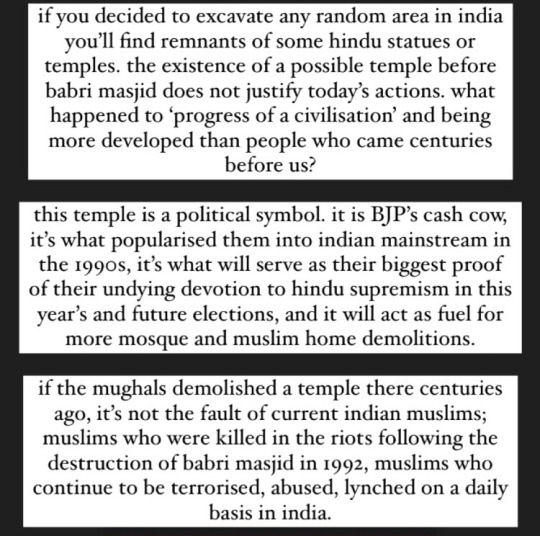
54 notes
·
View notes
Text
Indian Prime Minister Narendra Modi inaugurated the Ram temple in Ayodhya in the key northern state of Uttar Pradesh in January in hopes it would earn him a massive victory in the national election that concluded in June. That didn’t happen—at least not to the extent that Modi, his Hindu-nationalist Bharatiya Janata Party (BJP), and their ideological fountainhead Rashtriya Swayamsevak Sangh (RSS) expected.
In what has widely been described as a shock result, the BJP won merely 240 seats in the 543-seat parliament, after setting a target of 400 seats. Modi has formed a government but only with support from other parties.
Like any election result, the outcome had multiple causes that will take time to fully sort out. But one thing is already clear: Modi failed in his long-running bid to homogenize India’s Hindus across castes and cultures and consolidate their vote for his political benefit.
In 2014, Modi came to power on the back of religious nationalism and security issues, and he continued that trend in 2019. This year, in the absence of any urgent security threat from regional rival Pakistan and rising concerns over unemployment, inflation, and authoritarianism, Modi banked on the RSS’s homogenization strategy.
The Ram temple was built on a site long disputed with Muslims, where a 16th-century mosque stood until December 1992, when a group of Hindu nationalists razed it to the ground allegedly on the BJP’s provocation. Experts said the BJP had envisaged the temple would instill pride in Hindus, feed their Muslim animosity, and bring them under the Hindu umbrella to choose Modi.
Even though, by and large, the Hindu community seemed to have been pleased with the inauguration of the temple, that didn’t translate into votes for Modi across the Hindu hierarchy. Instead, the results exposed the weaknesses of the homogenization exercise.
Hartosh Singh Bal, an Indian journalist and the executive editor of the Caravan, said there is “diversity in Hinduism” and the election results prove that it can’t be “papered over by directing attention and hatred outwards” toward Muslims. This election proves that “Hindus are not a monolith” and that “various segments of Hinduism have a successful chance of taking on the BJP,” he added in reference to tactical voting by lower castes in Uttar Pradesh against the BJP.
Karthick Ram Manoharan, a political scientist at the National Law School of India University in Bengaluru, said that in Tamil Nadu, a state in southern India with the second-biggest economy in the country, the BJP did not win a single seat out of a total of 39.
“Hindus are the absolute majority in Tamil Nadu, but they still mostly vote for the secular Dravidian parties,” Manoharan said in reference to local parties that have emerged out of social movements opposed to an upper-caste Hindu order that the BJP and RSS have been long accused of nurturing and propagating.
In March, just a month before voting began, I witnessed saffron-colored flags expressing support for Modi’s party jutting out from rooftops and windows in tightly packed homes in western Uttar Pradesh. Some people I spoke to said that BJP workers had decided to adorn the neighborhoods as they pleased, but underneath the flag-waving, a large-scale discontent was brewing over a lack of employment opportunities.
The upper-caste youth seemed confused, if not yet disenchanted, with Modi and in the absence of industry and strong local economies once again mourned the loss of government jobs to affirmative action. (The Indian Constitution reserves almost half of all state jobs for people from lower castes and others who confront a generational disadvantage and historical discrimination.)
Meanwhile, Dalits, who sit at the bottom of India’s Hindu hierarchy, in hamlets nearby who depend on the quota for their dignity and livelihood were quietly recalibrating their options. The mood was starkly different from 2014 and 2019 when I visited some of the Dalit-dominated parliamentary seats in Uttar Pradesh. Back then, Dalits I met were upbeat and decisively pro-Modi. They said they supported him since they believed that he might raise their stature in the Hindu hierarchy.
But 10 years later, they suspected the BJP was plotting to weaken the constitution, the only assurance of rights for marginalized communities in a country where upper-caste Hindus continue to hold social capital and economic power.
Recent comments by BJP leaders that if Modi won 400 seats, he would change the constitution spread anxiety among lower castes that the party intended to scrap the reservation system. The BJP repeatedly denied this, but the suspicion that it is first a party for upper-caste Hindus is deep-rooted among lower castes, and experts believe the comments were part of the BJP’s political strategy.
“They were testing the waters to see what would be the reaction,” said Sushil Kumar Pandey, an assistant professor of history at Babasaheb Bhimrao Ambedkar University in Lucknow and the author of Caste and Politics in Democracy.
“The opposition picked it up and campaigned on it, telling people a change in the constitution could mean losing your livelihood, your jobs,” Pandey added. “That worked at a time [when] people were also scared of privatization” and in government-run sectors.
For Dalits, it was about more than jobs. The Indian Constitution is nearly worshipped by the community and celebrated en masse on the birth anniversary of the Indian intellectual who wrote it. B.R. Ambedkar was no fan of Ram and advocated against the caste discrimination inherent in Hinduism all his life, even converting to Buddhism when he felt there was no escaping caste-based prejudice. While he couldn’t annihilate the caste system, he ensured that the constitution offered lower castes a quota in government jobs to gradually uplift them.
In his honor, and as an ode to the progressive document, Dalits sing songs in praise of the constitution and hail it as the upholder of their dignity in a society where they continue to be belittled. Any change to the text was unacceptable. “Their cultural identity is linked to this book,” said Ravish Kumar, a journalist and the host of a popular YouTube news show.
In the south, too, there was a fear of culturally being subsumed by a Hindi-speaking upper-caste elite. Indian federal units, or states, were defined in the 1950s on the basis of language, and to this day south Indians identify themselves on the basis of the language they speak. The Ram temple had no resonance in the southern states, particularly in electorally significant Tamil Nadu, with the highest number of seats regionally. Tamils were wary that the RSS’s homogenization agenda would drown out their cultural ethos and impose a secondary status on the Tamil language.
Manoharan, the political scientist, said that in Tamil Nadu, it was “not so much religious but fear of cultural homogeneity” and “a language policy which will give importance to Hindi speakers over Tamil speakers and upper-caste Tamils over other backward castes.”
In a state where “88 percent people come from so-called lower castes” and “69 percent have jobs under affirmative action through a special act,” people were also extremely worried that the BJP may “water down” the employment quota promised in the constitution, Manoharan added.
The southern Indian states have a longer history of resistance to upper-caste domination, a higher literacy rate, better economies, and a tradition of secular politics. While the BJP maintained its tally of 29 seats from the last election, it is being seen as a poor result considering the inroads the RSS has made in the south.
For instance, in the southwestern state of Kerala, the RSS has more than 5,000 shakhas, or branches, second in number only to Uttar Pradesh, India’s most populous state—yet “despite the fact that the RSS has thousands of training grounds in Kerala, they are unable to get influence,” said K.M. Sajad Ibrahim, a professor of political science at University of Kerala. “That’s because while religion is important, communal harmony is more important to people here. BJP tries to create tensions, and that doesn’t work here.”
The BJP managed to gain one seat for the first time in Kerala, but that isn’t being attributed to its ideological success or expansion of homogenization project but to the winning candidate’s personal appeal. Suresh Gopi, the winning candidate, is a popular movie star.
In many states in the Hindi belt and even in the south, the BJP did well. The upper castes and urban voters are standing firmly behind Modi. Kumar, the journalist, said it would be foolhardy to dismiss Modi—and the bigger Hindutva, or Hindu nationalist, forces backing him—just yet. He said Hindutva hasn’t lost and only faced a setback. “The BJP was trying to dominate caste politics with Hindutva,” he said, “but the election result shows that dominance has cracked.” However, he added, “it has only cracked—the ideology still has wide-scale acceptance.”
Everyone else Foreign Policy spoke to concurred but added that Hindus are far too diverse to be homogenized. Manoharan said the results exposed the weakness of the homogenization agenda and its faulty premise. “Hindutva’s aim for homogeneity is confounded precisely by a structural feature of the religion-culture it seeks to defend—caste,” he said.
22 notes
·
View notes
Text
A Bollywood film that portrays the capture and execution of an Indian warrior king by a 17th century Mughal ruler has fuelled street protests and demands from right-wing groups to demolish the emperor’s tomb.
Authorities have now tightened security around the tomb of Aurangzeb Alamgir in the western Indian state of Maharashtra after right-wing groups threatened to raze the monument.
On Monday, violence erupted in Nagpur following rumours of a holy book being desecrated. Police reportedly used tear gas to disperse the mob, and four policemen were injured. Police said they had detained dozens of people after 30 were injured and a similar number of vehicles torched.
“After the release of the film Chhaava, the views of many people on the Mughal emperor have turned extreme, as seen in social media posts,” local authorities said in a statement on 15 March.
Chhaava portrays the life and times of Chhatrapati Sambhaji Maharaj, who was the second ruler of the Indian Maratha empire and the eldest son of the 17th-century Indian warrior king Chhatrapati Shivaji Maharaj. Shivaji is revered in western India as a Hindu ruler who fought the Mughals and established a Maratha kingdom. “Chhaava” is a Marathi-language word which means lion’s cub.
Right-wing groups such as the Vishwa Hindu Parishad and the Bajrang Dal threatened to demolish the tomb in Khuldabad town in Chhatrapati Sambhajinagar district (formally known as Aurangabad) as they claim it is a reminder of “centuries of oppression, atrocities, and slavery” of Hindus during the Muslim emperor’s rule.
The groups threatened a “Babri-like” repeat if the tomb is not razed, referring to the demolition of the Babri Masjid (mosque) in Ayodhya in 1992 which sparked nationwide religious riots, killing more than 3,000 people in a decades-long dispute that fuelled Hindu-Muslim tensions in the country.
The groups, according to the news outlet India Today, pledged “karseva” if the government does not act on their demands. “Karseva” is a Sanskrit word which means voluntarily offering services for religious causes. In 1992, several religious volunteers called “karsevaks” were responsible for demolishing the Babri mosque.
The right-wing groups had earlier announced a statewide protest on Monday to demand the removal of the tomb, following which police deployed additional forces around the tomb and restricted entry to prevent any unrest.
Chhaava, directed by Laxman Utekar, was released in February, and was successful at the box office. It portrayed the captivity, torture and execution of Shivaji's son. But many called the film out for its “clumsy grip on history” and leaving “no room for complexity”.
“Chhaava does have the laudable goal of setting the historical record straight about Sambhaji as a great warrior and administrator against biased accounts. But it becomes harmful national-level propaganda when it is fixated on the good Hindu versus the bad Muslim binary, skips some incontrovertible facts, and is in complete sync with the ruling party’s ideology,” wrote Nissim Mannathukkaren, chair of Dalhousie University's department of international development studies, in The Hindu.
It also sparked extreme reactions among audiences. A fan in Nagpur rode a horse to the theatre to imitate the Hindu king, while in Gujarat, a man vandalised a cinema screen in anger over a scene depicting the torture of Sambhaji.
Last week, after two Indian politicians – Nitesh Rane and Navneet Rana – called for the tomb’s removal, chief minister Devendra Fadnavis backed the proposal but stressed that any action must follow legal procedures, as the historical site is protected by the Archaeological Survey of India (ASI).
Aurangzeb, the sixth Mughal emperor, ruled from 1658 until his death in 1707 and was engaged in a prolonged war with the Marathas in present-day Maharashtra.
During a press meet, Kishor Chavan, a coordinator for the VHP in western Maharashtra, said: “Aurangzeb’s cruelty is well-documented – he imprisoned his own father, executed his brothers, and ordered the destruction of Hindu temples. The existence of his tomb only serves to glorify his atrocities, and the Maharashtra government must act immediately to remove it. If government fails to remove it, we will do it by holding ‘karseva’, like we observed during the Ram Janmabhoomi movement.”
The Ram Janmabhoomi movement was a Hindu nationalist campaign pushing for the construction of a temple (dedicated to the Hindu deity Ram) at the site of the mosque in Ayodhya, leading to the demolition of the Babri mosque and the eventual building of the Ram temple that Hindu nationalist prime minister Narendra Modi inaugurated in January 2024.
The tensions in Maharashtra over Aurangzeb’s tomb come amid controversy over the state Samajwadi Party legislator Abu Azmi’s remarks about the Mughal emperor, which led to his suspension from the state assembly until 26 March and multiple police complaints against him.
“Wrong things are being said about Aurangzeb. He constructed a lot of temples for Hindus. He even got one of his soldiers trampled by elephants when he wanted to marry a Hindu priest’s daughter. As a mark of their gratitude, they constructed a mosque for Muslims. History has been distorted,” Mr Azmi remarked earlier this month.
It led to Maharashtra deputy chief minister Eknath Shinde demanding an apology from Mr Azmi and saying that he should be tried for treason.
Opposition Congress MP Kalyan Kale accused political groups of deliberately stoking controversy over Aurangzeb’s tomb to polarise voters ahead of the legislative council by-elections. He called it a strategic move to raise communal issues for electoral gain.
“The tomb has been there for years. Many are seeing it now only because elections are around.”
“If they want to remove the grave of the Aurangzeb, then what about various structures built by the Mughals across India?” Imtiaz Jaleel, a former member of parliament, was quoted as saying by The Hindustan Times.
Controversies surrounding Aurangzeb aren’t exactly new – prime minister Narendra Modi has referenced the long-dead Mughal emperor in his speeches in the past. “Aurangzeb severed many heads, but he could not shake our faith,” Mr Modi had said in 2022 during an event at the Mughal-era Red Fort in the capital Delhi.
In May 2022, the ASI temporarily barred public visits to the site following threats of vandalism from the Maharashtra Navnirman Sena (MNS), a regional party. The MNS had called for the tomb’s destruction, leading to increased security measures and a five-day closure.
In 2023, another AIMIM leader Akbaruddin Owaisi’s visit to Aurangzeb’s tomb sparked a political controversy, and was also met with increased security at the site.
On Tuesday, Maharashtra’s chief minister Devendra Fadnavis held Chhaava responsible for the violence in Nagpur. “This violent incident and riots seem to be pre-planned,” he said during a speech in the legislative assembly. “Chhaava has ignited people’s anger against Aurangzeb.” He added that “everyone must keep Maharashtra peaceful”.
5 notes
·
View notes
Text
“Ram Mandir Ayodhya”
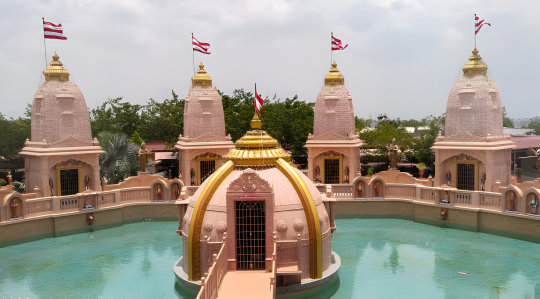
Let's talk about the beauty of India – “Ram Mandir Ayodhya”.
The story of Ram Mandir dates back to ancient times when Ayodhya was the capital of the mighty kingdom of Kosala. The revered epic, Ramayana, chronicles Rama's life, his exile, and the triumph of good over evil in the form of the demon king Ravana. Ram Mandir - the living testament to the confluence of history, devotion, and the collective heartbeat of a nation. This sacred sanctuary, arising from the dust of centuries, is not just a place of worship but a symphony of stories etched into the very soul of India. The journey towards the construction of this magnificent temple is woven into the very fabric of India's rich cultural tapestry, blending history, religion, and the collective consciousness of millions.
"The Melody of Ages: Echoes of Timeless Tales within the Sacred Halls of the Ram Mandir Ayodhya"
Travel back in time to the days of the illustrious Kosala kingdom, with Ayodhya as its pulsating heart. Here, the epic of Lord Rama unfolded, a saga written across the skies and etched into the very earth upon which the Ram Mandir now stands. The Ramayana, that timeless scripture, narrates the divine odyssey of Rama, his trials, and the eventual triumph of virtue over vice. Ayodhya's spiritual gravity, rooted in the belief that the temple site is the sacred birthplace of Lord Rama, has beckoned pilgrims and seekers for centuries. This hallowed ground, now adorned by the resplendent Ram Mandir, echoes with the footsteps of those who sought solace in the embrace of devotion. The significance of Ayodhya in the Ramayana laid the foundation for the belief that the very spot where the temple stands today is the birthplace of Lord Rama. Over the centuries, Ayodhya became a symbol of devotion for millions of Hindus worldwide, fostering a deep spiritual connection to the Ram Janmabhoomi.
"Endurance Through Time: Tracing the Centuries-Long Struggle Leading to the Ram Mandir Ayodhya"
The narrative of the Ram Janmabhoomi also carries the weight of centuries of struggle and disputes. The Babri Masjid, built in the 16th century, stood on the same site, leading to a complex and emotionally charged legal and social battle. Decades of legal wrangling reached a pivotal moment in 2019 when the Supreme Court rendered a verdict in favor of constructing the Ram Mandir, a decision that recognized the sentiments of millions and sought to heal historical wounds.
"Sculpting Divinity: Exploring the Architectural Marvels and Spiritual Essence of the Ram Mandir"
The Ram Mandir isn't just a temple; it's a masterpiece of architectural poetry. The design of the Ram Mandir is a harmonious blend of architectural brilliance and spiritual symbolism. Its three-storied splendor is a canvas painted with intricate carvings, soaring domes, and spires that seem to touch the heavens. The sanctum sanctorum cradles the divine family – Lord Rama, Sita, Lakshmana, and Hanuman – in an ethereal embrace. Wander through the temple complex, and you'll be mesmerized by sculptures breathing life into the Ramayana. Each intricately carved scene tells a story, inviting devotees and visitors to immerse themselves in the rich tapestry of Rama's journey. The temple complex also features captivating sculptures depicting scenes from the Ramayana, inviting devotees to relive the epic saga of Rama. The sacredness of the site is enhanced by the serene surroundings, creating a tranquil atmosphere conducive to prayer and contemplation.
"A Symbol of Unity: The Ram Mandir Ayodhya, Bridging Hearts and Faiths in a Tapestry of Harmony"
The construction of the Ram Mandir has been a unifying force for the nation, transcending religious and cultural boundaries. The Ram Mandir, rising from the heart of Ayodhya, is more than an architectural marvel – it is a beacon of unity. Its construction serves as a reminder that within the varied threads of India's cultural fabric, there exists a harmonious tapestry. It exemplifies the spirit of inclusivity, fostering a sense of belonging for people of all faiths. The dedication of the temple to the ideals of Lord Rama, such as righteousness, justice, and compassion, sends a powerful message of unity in diversity. The temple transcends religious boundaries, inviting people from all walks of life to partake in the divine aura that permeates the air. The Ram Mandir Ayodhya stands as a testament to the enduring power of faith, the resilience of a nation, and the ability to overcome centuries of challenges. As pilgrims and wanderers alike embark on a pilgrimage to Ayodhya, they are greeted not just by stone and mortar but by the living essence of the Ram Mandir. It is not merely a structure of stone and mortar; it is a living embodiment of the values that have shaped the cultural landscape of India for millennia. It is a sanctuary where the past dances with the present, where devotion intertwines with heritage, and where the melody of unity resonates through the ages. In the shadows of this sacred abode, Ayodhya continues to weave its tales, inviting all to be a part of its eternal narrative. As pilgrims and tourists alike flock to Ayodhya to witness this architectural marvel, they partake in a journey through history, mythology, and the unwavering spirit of devotion that defines the essence of the Ram Mandir.
Now let's talk about the spritual date for all Hindus! and Ram Bhakts 22nd January 2024
"The Unveiling of Ram Mandir Ayodhya on January 22nd, 2024"
First let me tell you something is that we are the luckiest generation that we are witnessing many years struggle of our ancestors coming to end. 22nd January 2024 is a memorable day for everyone. On the auspicious day of January 22, 2024, the spiritual landscape of Ayodhya witnessed a historic moment that reverberated through the hearts of millions – the grand opening of the Ram Mandir. After decades of legal and societal debates, the culmination of the construction process marked a significant milestone in the religious and cultural history of India. Devotees, dignitaries, and people from all walks of life gathered in Ayodhya to witness the inauguration ceremony. The air was thick with anticipation and reverence as the doors of the Ram Mandir swung open, revealing a breathtaking architectural marvel. The three-storied structure, adorned with intricate carvings and symbolic representations from the Ramayana, stood as a testament to both faith and craftsmanship.
The sanctum sanctorum, the heart of the temple, housed the divine idols of Lord Rama, Goddess Sita, Lakshmana, and Hanuman. Pilgrims and visitors alike marveled at the spiritual aura enveloping the sacred space, where centuries of devotion found a tangible expression.
The opening of the Ram Mandir was not merely a religious event; it was a moment of unity and harmony. People from diverse backgrounds came together to celebrate the cultural heritage woven into the very fabric of Ayodhya. The resonance of hymns and prayers echoed through the city, carrying with them the hopes and aspirations of a nation united in reverence for Lord Rama.
17 notes
·
View notes
Text
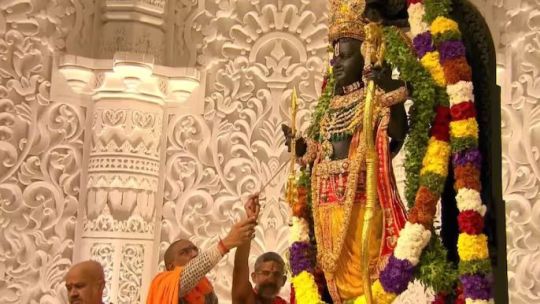
The 500-year wait is over! Lord Ram is home!! Check out the full timeline:🔽🔽 - 1528: According to the history books, Babur's general Mir Baq was in charge of constructing the Babri masjid at the place where Lord Ram was born. The old temple was destroyed to construct the mosque.
- 1530-65: Unverified reports suggest communal violence over the Mandir-Masjid debate and Akbar, the then Mughal ruler, set up a common platform for worship. - 1853-85: After almost 330 years, communal violence erupts again. The British Empire sets up partitions and Mahant Das’s plea to build a canopy above the platform is denied. - 1949: The turning point comes when the idol of Lord Ram appears from inside the mosque. According to Muslims, the idol was placed inside the mosque by a radical Hindu outfit. As both parties file multiple lawsuits, the situation gets more complicated.
- 1950-61: Multiple lawsuits are filed and other parties join the fray with both sides claiming the land as theirs. - 1983-1989: The Vishwa Hindu Parishad (VHP) starts a nationwide move to build a temple and legal tensions flare up. Muslims set up the Babri Masjid Committee and the former VP of the VHP files a suit on behalf of Lord Ram to get possession and the first stone for the temple is laid. - 1990: BJP leader Lal Krishna Advani’s Rath Yatra from Somnath to Ayodhya saw thousands of volunteers march as they partially damaged the mosque in a scuffle that left scores dead. - 1992: The bloodiest event in the Mandir-Masjid dispute as Hindu volunteers demolish the mosque and a bloody battle erupts throughout the nation. Over 2,000 were reported dead. A small tent is set up where the idol is placed for worship. - 2002: PM Atal Bihari Vajpayee sets up an Ayodhya cell and the Allahabad HC judges begin determining ownership of the site. - 2003: The Archaeological Survey of India begins surveying the area and a survey reveals the existence of a temple’s remains beneath the mosque. Muslims challenge the findings as tensions continue. - 2010: The disputed land is split into 3 parts where one went to the Hindus, another to the Muslims, and the final one to the Nirmohi Akhara. - 2011: All 3 parties approach the Supreme Court to challenge the Allahabad HC’s judgment and the SC issues a stay on the order. - 2015-18: The SC removes all irrelevant parties from the lawsuit as the matter gets more sensitive during that time. - 2019: After a failed mediation attempt, a five-judge bench announces a judgment in favor of the Hindus, and the Muslims are allotted 5 acres for the construction of another mosque. - 2020: PM Narendra Modi lays the foundation stone for the construction alongside a commemorative plaque and a special postage stamp. - 22nd January 2024: The temple is officially consecrated and Lord Ram, who has been in a tent since 1992, is unveiled for worship in a state-of-the-art temple. Follow Jobaaj Stories (the Media arm of Jobaaj.com Group) for more.
7 notes
·
View notes
Text
https://www.naturallife365.com/why-indias-new-ram-temple-is-so-important
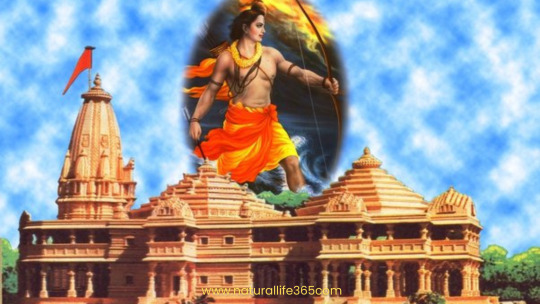
Why India’s New Ram Temple Is So Important?
On the historic day of January 22, 2024, amidst chants of ancient hymns and jubilant cheers echoing through the air, India witnessed a momentous event that reverberated across the nation and beyond its borders. Indian Prime Minister Narendra Modi stood before a grand assembly in the sacred city of Ayodhya, marking the inauguration of a long-awaited symbol of faith and devotion: the magnificent Ram Temple.
For generations, the city of Ayodhya has been enshrined in the hearts and minds of millions as the birthplace of Lord Ram, a revered figure in Hindu mythology and a symbol of righteousness, compassion, and divinity. However, Ayodhya's history has been marred by centuries of discord and contention, particularly surrounding the site where the Ram Temple now stands.
The journey to the construction of the Ram Temple has been a tumultuous one, punctuated by legal battles, political debates, and deeply entrenched religious sentiments. The site, once occupied by the Babri Masjid, became a flashpoint for communal tensions, culminating in its destruction in 1992 and igniting one of the most contentious disputes in modern Indian history.
After decades of legal deliberation and societal upheaval, the Indian judiciary finally rendered a landmark verdict in 2019, paving the way for the construction of the Ram Temple on the disputed site. The subsequent years saw meticulous planning, fervent dedication, and unwavering resolve as the dream of millions gradually took shape in the form of a magnificent architectural marvel.
As Prime Minister Modi ceremoniously laid the foundation stone and inaugurated the grand edifice, he not only marked the culmination of a long-standing aspiration but also ushered in a new era of hope, unity, and spiritual rejuvenation for the nation. The significance of India's New Ram Temple extends far beyond its architectural splendor; it embodies the resilience of faith, the triumph of justice, and the enduring spirit of a nation bound by its shared heritage and beliefs.
In this blog, we delve into the multifaceted importance of India's New Ram Temple, exploring its historical roots, cultural significance, religious symbolism, and contemporary implications. Join me on a journey through time and tradition as we unravel the profound significance of this monumental endeavor and its enduring impact on the fabric of Indian society.
#tumblog#blogs#reading#literature#my writing#blogger#blog#hindublr#hinduism#hindu#bharat#sanatandharma#hindu mythology#ram mandir#temple#hindutva#shrine#ayodhya#ayodharammandir
4 notes
·
View notes
Text
Part of why I follow what's going on with hindu nationalism is, obviously, that I think fascism is bad and people shouldn't suffer. Part of it is just pure curiosity, admittedly. Part of it is that I feel like it's something underlooked and underreported. Part of it is that I stumbled on the Ayodhya dispute specifically due to my interest in the statue of ram (which isnt even close to completion, and also i cant care to see anymore after finding out its part of the hindutva project), and then I just started keeping up with the story, eventually finding out it was an extremely important moment for hindutva. Part of it is that I think it's important to follow what a genocidal religious nationalist government does in the most populous country in the world - at the moment, I'm not afraid it's going to ever hurt me, but it's just horrible to see
3 notes
·
View notes
Text
Seek Lord Ram's Forgiveness, Because…": PM Modi On Ayodhya Temple
Addressing the large gathering after the 'pran pratistha' rituals at the grand Ram Temple in Ayodhya, Prime Minister Narendra Modi today said, "Our Ram has finally arrived." "I have come before you are witnessing the divine consciousness in the temple's sanctum sanctorum. There's so much to say but, but there's a lump in my throat. After unprecedented patience, innumerable sacrifices and penance, our Lord Ram has arrived. I congratulate the country on this occasion," the Prime Minister said.

Ram Lalla, he said, will "no longer live in a tent". Saying that this moment of consecration is a blessing from Lord Ram, he said January 22 is "not a date on a calendar, but the dawn of a new era".
Equating the consecration ceremony with breaking free of a mindset of slavery, he said it is a blessing that we are alive to witness this historic event. "Even after thousands of years, people will remember this date, moment. It is Ram's supreme blessings that we are witnessing it," he said. He also sought forgiveness from the deity and said there must have been some lapse because of which it took so long to reach this point.
Saying that "Ram's existence was questioned", the Prime Minister said, "In India's Constitution, in its first page, there's Lord Ram. I thank the Supreme Court for maintaining the dignity of law."
Some people, he said, had warned that the construction of the Ram Temple will light a fire. "Such people could not understand the purity of India's social consciousness. The construction of this temple of Ram Lalla is also a symbol of the Indian society's peace, patience and mutual harmony. We can see this has not given birth to a fire, but an energy," he said.
"Ram is not a fire, he is an energy. Ram is not a dispute, he is a solution. Ram is not just ours, he is everyone's," the Prime Minister said, adding, "Today, we did not just see the pran pratishtha of Ram Lalla's idol, but also the pran pratishtha of the unbreakable unity of India."
Laying down a vision for the country's development in the future, the Prime Minister said, "Ram's temple has been built. Now what? Every citizen's consciousness should extend from dev (god) to desh (country) and from Ram to rashtra (nation)."
2 notes
·
View notes
Text
even more so, they lost in the constituency of ayodhya. this is significant because the party in question had wanted to appeal to votes of the hindu community by building a long-disputed temple in ayodhya, of a God (Rama) who was born there and ruled there. the temple is considered his birthplace. (i wont get into the dispute, google it if interested or dm me for sources.) this is also very fucking funny for several reasons. many of those being the main villain of rama's story and the themes surrounding him: ravana, the prideful demon king. pride was his fatal flaw and what caused his defeat at the hands of rama. it's like breaking the pride of the leader of the prideful fascist pm. to quote to my best friend, "the people of ayodhya understood the assignment."
although that is not to say our opposition is any less fascist, they're just fascists in the opposite direction. therefore, neither's plans related to fascism will pass in the parliament lmao (let's hope)
take a moment to read indian election news!! india has voted against the ruling fascist party. while they will resume government they will need to forge alliances and have lost multiple strong members of parliament. and all this despite them controlling the media and jailing their opposers! this is SUCH an important reminder that u shld never ever underestimate the power of a vote
#indian elections#lord rama really went: another prideful asshole not again#ugh guess my people will have to do it themselves#and so they did#among others ofc the people of ayodhya don't get the Full credit ofc#but it is really fucking funny if you're an indian and understand the irony of it all
12K notes
·
View notes
Text
#Ram Lalla#Ram Mandir#Ayodhya#Lord Ram#Hinduism#Divine Child#Spirituality#Temple Construction#FaithIn Ram#Cultural Heritage#Religious Harmony#Pilgrimage#SacredIdol#Ramayana#Divine Blessings#Ayodhya Land Dispute#Supreme Court Verdict#Hindu Tradition#Religious Unity
0 notes
Photo

Jun 28, 2025 03:59 PM IST The temple's development committee chief mentioned titanium was chosen for its power and lightweight weight. This is the primary time it is getting used this fashion in India. The window grills of the Shri Ram Janmabhoomi temple will probably be crafted from titanium, marking a first-of-its-kind use in India, information company ANI reported citing Shri Ram Janmabhoomi Teerth Kshetra development committee chairman Nripendra Mishra on Saturday. In addition to particulars on the titanium window grills, Mishra additionally shared updates on stone procurement for the temple. (PTI) He mentioned that the choice was made resulting from titanium’s power and light-weight nature in comparison with different metals. "For the first time in the country, the grills of windows of the temple will be made of titanium metal. This is unique because you know that titanium has a very long lifespan, exceeding a thousand years. And that metal is lighter than other metals," Mishra instructed reporters. In addition to particulars on the titanium window grills, Mishra additionally shared updates on stone procurement for the temple. He mentioned round 14 lakh cubic toes of stone from Bansi Paharpur was initially deliberate for the mission, however just one hundred lakh cubic toes now stays for use. Update on ‘most important work’ of the templeLast week, Shri Ram Janmabhoomi Teerth Kshetra Trust common secretary Champat Rai said that the Ram temple in Ayodhya is in its closing section, with ending touches at present underway. Speaking to reporters, Rai talked about that after this stage is accomplished, all heavy equipment will probably be faraway from the location. He added that the "main work of the temple will be completed by October." Rai careworn the significance of making certain that public 'darshan' (viewing) continues with out disruption. He identified that key infrastructure parts – such because the boundary wall, auditorium, restrooms, and the Trust’s workplace – are nonetheless pending and "may take another year to be completed." Earlier, on May 2, the temple development committee held a three-day assembly in Ayodhya to evaluate the progress of the mission. On the primary day, committee president Nripendra Mishra shared key updates after web site inspections. He famous that, barring two parts, nearly all of the development will probably be completed by the top of 2025. “Except for developing a four-kilometre boundary wall and the auditorium, all different constructions will probably be accomplished by December 2025,” Mishra remarked. He additionally talked about that almost all idols have already reached their designated locations inside the complicated. Only two idols—one for the Ram Darbar and one other for the Shesha Avatar temple—are but to be put in. The Ram Darbar idol will probably be positioned within the sanctum sanctorum on May 23, whereas the opposite will probably be put in earlier than May 30. The temple’s development adopted a landmark Supreme Court ruling in 2019 that resolved the long-standing Ram Janmabhoomi-Babri Masjid title dispute. Hindu petitioners had claimed the mosque was constructed on the birthplace of Lord Ram. The consecration ceremony for the temple was held on January 22 final 12 months. Read More: https://news.unicaus.in/india/ayodhyas-ram-temple-to-have-titanium-window-grilles-a-primary-in-india-nripendra-mishra/
0 notes
Text
Godhra: True Story
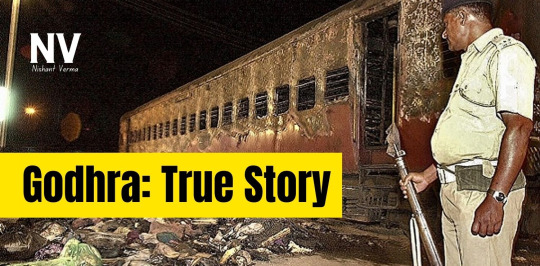
The Godhra incident and the riots that followed in 2002 are a highly sensitive and complex topic in India’s history. The incident occurred on February 27, 2002, when a train coach, the S-6 coach of the Sabarmati Express, was set on fire near the Godhra railway station in Gujarat. This tragic event resulted in the death of 59 people, most of whom were karsevaks (Hindu pilgrims) returning from Ayodhya. This incident ignited widespread communal violence across Gujarat, leading to the deaths of hundreds and leaving a long-lasting impact on the state and the country.
The Godhra Train Burning Incident
On the morning of February 27, 2002, the Sabarmati Express, carrying karsevaks from Ayodhya, made a brief stop at Godhra railway station in Gujarat. According to reports, there was a dispute between the passengers and vendors at the station, which escalated rapidly. Soon after the train left the station, a mob reportedly gathered near the train, and within minutes, the S-6 coach was engulfed in flames. The fire led to the death of 59 passengers, including women and children.

Aftermath: The Riots
The Godhra train burning incident triggered widespread riots across Gujarat, which lasted for several weeks. These riots were marked by intense violence, arson, looting, and killings, leading to the deaths of around 1,000 to 2,000 people, the majority of whom were Muslims. The violence spread rapidly to many parts of the state, and large-scale destruction of property took place.
The scale and intensity of the riots were alarming, and it soon became clear that law and order had broken down in many areas. There were reports of mobs attacking homes, businesses, and places of worship. Many people lost their lives in these targeted attacks, and thousands were displaced, seeking refuge in relief camps.
Political and Social Repercussions
The handling of the riots by the state government, led by then Chief Minister Narendra Modi, came under severe scrutiny. Many alleged that the administration and the police were complicit in the violence or failed to take adequate measures to control the situation. Accusations of bias and inaction were widespread, with some claiming that the state machinery had turned a blind eye to the violence.
This perception led to national and international condemnation, with human rights organizations, the media, and political figures raising concerns over the role of the government and law enforcement agencies. The Indian central government, led by the then-Prime Minister Atal Bihari Vajpayee, faced immense pressure to intervene, and there were calls for the dismissal of the Gujarat government.
If you want to more about on this you can visit Nishant verma blogs.
0 notes
Text
What today’s India-Pakistan attacks (and ceasefire) means for Ukraine War

Editor’s Note:
Our team responds to the news as quickly as possible – including today’s attacks between Pakistan/India and ceasefire – by immersing ourselves in the experiences of those living through those events.
If you are eager to hear them, upgrade to a paid subscription and support our work.
Upgrade Now!
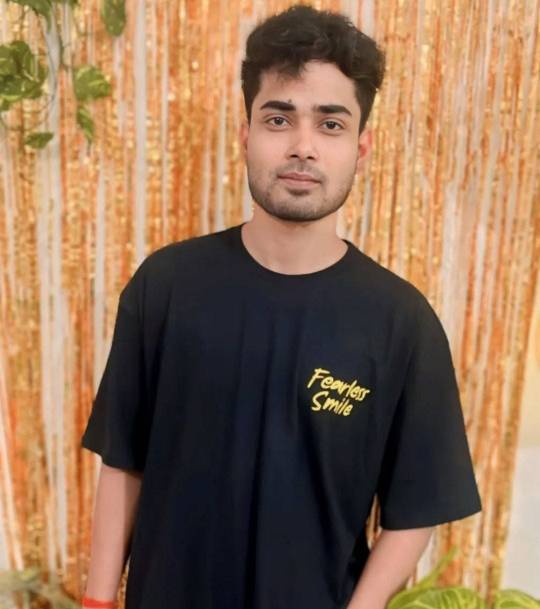
Dr. Jattashankar Sinha in India. Photo provided by the subject.
After spending about 3-4 months under constant Russian attacks, Jattashankar got used to it.
“I was mentally prepared when they [Russians] launched drones and ballistic missiles… You will see the drones here and there,” he said.
Jattashankar Sinha, born and raised in Ayodhya, India, lived in Ukraine for a year during the full-scale Russian invasion.
But as the war raged on, he decided to go back to his home country. Fleeing one war, Jattashankar stumbled upon escalation in his native land: new attacks between two long-standing nuclear-armed adversaries: India and Pakistan.
Today, Pakistan launched yet another attack on India. Now, news is breaking over the last few hours about how the two countries agreed to an immediate, but tenuous, ceasefire.
The recent escalation of the conflict between India and Pakistan was not merely a localized dispute. It represents a global threat as both nations possess nuclear capabilities and are standing on the brink of a full-scale war.
The conflict poses a risk to the arms supply chains to Ukraine. Although both countries officially maintain neutrality, their weapons indirectly end up on the battlefield in Ukraine. At a time when every source of military support is vital, Kyiv risks losing access to additional arms needed for its defense.
As the whole world was anxiously monitoring the escalation between two nuke-armed long-time rivals, the unpredictable and lightning-fast ceasefire calls into question the full resolution of the conflict and still does not provide clarity on the onset of stability in the South Asian region.
The Indian expat community in Ukraine remains significant despite the government’s ambiguous stance on Russia’s invasion. There are about 18,000 Indian students enrolled in universities in Kyiv, primarily pursuing degrees in medicine and engineering.
“Living and studying medicine in a war-torn Ukraine taught me resilience in the face of fear, unpredictability, and loss. I learned how to keep calm under pressure, to adapt quickly, and to stay focused on saving lives even when sirens were blaring outside. That experience prepared me mentally for what’s happening now in my own country, ” Jattashankar said.
Dr. Jattashankar Sinha is from Ayodhya, India. He came to Ukraine in 2017 to pursue a medical degree at the National Bohomolets University in Kyiv, as he hadn’t qualified for the entry exam in India. Several students from India consider Ukraine an option for education, as universities are cheaper here.
In Ukraine, medical education costs from $700 to $1,800 per year. In India, prices average $1,600 up to as much as $20,500 per year.
“Ukraine is in my list of favorite countries. It is so beautiful. Especially the West[ern] part of Ukraine,” Jattashankar said.
After the start of the full-scale invasion, Jatashankar went home to India, before returning in 2023 to spend another year in Ukraine.

Photo depicts the wreckage of an aircraft that crashed in Wuyan Pampore in Kashmir. India launched airstrikes on Pakistan and Pakistan-administered Kashmir on May 7, while Pakistan claims it shut down two Indian jets. (Photo by BASIT ZARGAR/Middle east images/AFP via Getty Images).
Over the last couple of weeks, he was living with another conflict being at his doorstep. Last month, a group of militants opened fire on tourists in the Kashmir town of Pahalgam, killing at least 26 people. In response, India attacked Pakistan on May 7, launching the so-called Operation Sindoor. Pakistan called the aggression an “act of war” and retaliated.
Today, Pakistan struck Indian military targets as part of its “Operation Bunyan Marsus” against India, which India called a “blatant escalation”. India's Foreign Secretary Vikram Misri announced Pakistani attacks on civilians and infrastructure and denied Pakistan's claims that India's critical infrastructure had been hit.
“After the brutal Pahalgam attack, where so many innocent people, mostly tourists, lost their lives, emotions were already running high.... But seeing things escalate further missile strikes, civilian areas being threatened brings a sense of fear and frustration… No one wants more lives lost on either side of the border. We have seen enough pain already,” Jattashankar shared today with The Counteroffensive.
President Trump claimed that the U.S. mediated the ceasefire, but sources on both sides quickly poured cold water on that notion.

Officials from both India and Pakistan confirmed the ceasefire had been reached, but said that diplomats from three dozen countries were involved in the agreement. An Indian source noted that the ceasefire deal was negotiated directly between India and Pakistan, despite Trump’s announcement that the U.S. had mediated the talks.
India’s Foreign Secretary Vikram Misri stated that military actions on the ground and firing between countries will stop at 5 pm local time. The two nations will speak again on May 12. The deescalation is already moving forward, and Pakistan announced it would reopen its airspace to all commercial and military flights.
Indian defense officials held a news conference in New Delhi to confirm the agreement but added they would remain alert to defend their country if necessary.
Pakistan and India have been in conflict for 78 years over Kashmir, a region that lies between the two nations. The dispute began in 1947, after the partition of British India, which led to the creation of two independent states: a predominantly Hindu India and a predominantly Muslim Pakistan.
At the time, the ruler of Kashmir hesitated to join either country as the state had both Hindu and Muslim populations. The indecision ignited a territorial conflict that has been growing ever since.
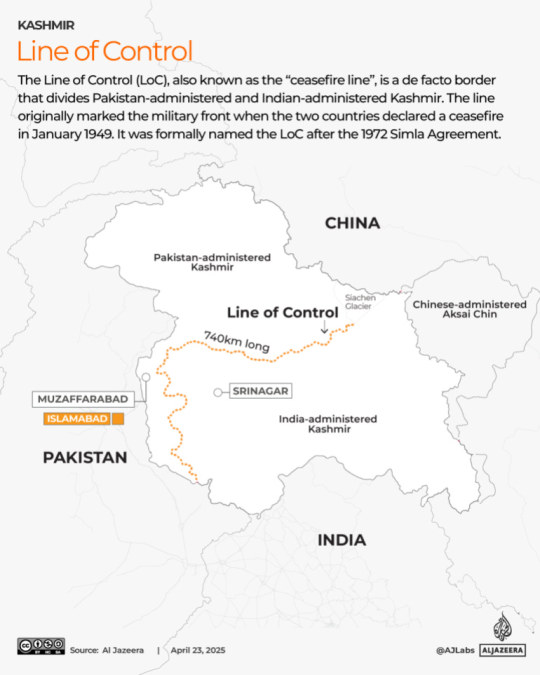
Map of the Kashmir territories controlled by India and Pakistan. Photo by Aljazeera.
Both countries officially claim the entire territory of Kashmir. A portion of it is also under Chinese control, although China has not claimed additional territory. China occupied the area in 1962 and has maintained control ever since. Prior to that, it was controlled by India, which continues to seek the territory back.
Jattashankar and his family live far from the conflict's epicenter and have remained calm. He said that he has “trust” in his army.
Ukraine has followed India’s footsteps and decided to remain neutral in the conflict between India and Pakistan, urging a “diplomatic solution to all contentious issues.”
“As an Indian, I view our country's approach to the Russia-Ukraine war as rooted in strategic autonomy. India has long followed a policy of non-alignment, and in today's multipolar world, that has evolved into maintaining strong relations with multiple powers without being drawn into blocs,” said Jattashankar.
Both Pakistan and India unofficially supply ammunition to the Ukrainian army.
Indian artillery ammunition may have reached Ukraine’s frontlines through European suppliers, such as Italy and the Czech Republic. These countries are leading the initiative to supply artillery shells to Kyiv from countries outside the European Union.
India officially denies the presence of its weapons in Ukraine. However, Russia, a close ally of India, has demanded that Delhi stop supplying weapons to Ukraine.
India probably faces the ongoing war in Ukraine and the rearmament of Europe as an opportunity to develop its defense sector.
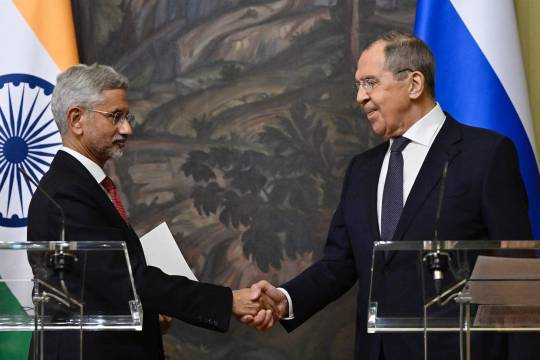
Russia's Foreign Minister Sergei Lavrov (R) shakes hands with India's Foreign Minister Subrahmanyam Jaishankar (L) following their talks in Moscow on December 27, 2023. (Photo by ALEXANDER NEMENOV/POOL/AFP via Getty Images).
Meanwhile, India is continuing to increase its cooperation with Russia. In 2024, it became Russia’s second-largest oil importer. The Russian military-industrial complex and the state’s budget depend on revenues from energy sales, as they account for 30 percent of government revenues.
This year, Russia and India signed their largest-ever oil supply agreement. Under this agreement, Moscow will supply Delhi nearly 500,000 barrels of crude oil daily for 10 years. Moreover, India remains the largest recipient of Russian arms exports, including the S-400 missile defense system.
“Prime Minister Modi's neutral stance, including his calls for diplomacy and dialogue, reflects India’s emphasis on peace and pragmatic engagement, especially given our deep economic and defense ties with both Russia and the West,” Jattashankar told The Counteroffensive. “Neutrality allows India to be a potential mediator and maintain its own interests without being entangled in distant wars. Our priorities lie in development, regional stability, and preserving strategic independence.”
The situation from the Pakistan side is even more prominent. After having reportedly supplied Ukraine and Israel with ammunition for the past years, it is now struggling with a shortage of artillery as conflict with India looms as a possibility.
In August 2022, journalists spotted a British Air Force plane making 12 trips between a military base in Pakistan and an international airport in Romania. It was allegedly transporting artillery shells of Pakistani origin to Ukraine.
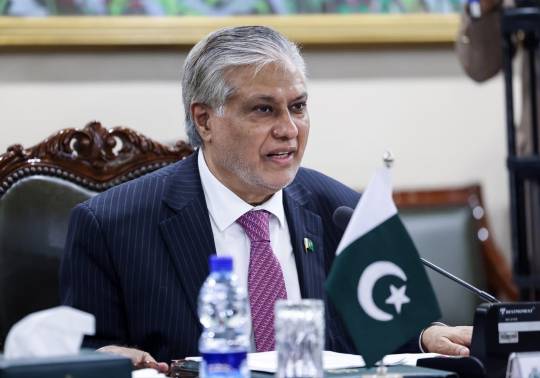
Turkish Foreign Minister Hakan Fidan (not seen) meets with Pakistan's Deputy Prime Minister and Foreign Minister Muhammad Ishaq Dar during his two-day official visit to Islamabad, Pakistan on May 20, 2024. (Photo by Murat Gok/Anadolu via Getty Images).
The Counteroffensive asked the State Customs Service of Ukraine about the import of weapons of Indian and Pakistani origin. We have not received a response.
While Ukraine is worried about the cessation of critical ammunition, an even bigger problem is brewing in the world: the possibility of a full-scale war between two nuclear countries rose over the last weeks and the ground of ceasefire agreement is still not clear.
“Personally, I didn't get flashbacks [of Russia’s war in Ukraine] from our own regional tensions when the war escalated, but it did highlight how quickly conflicts can escalate and the importance of diplomacy, especially in nuclear-armed regions like ours,” Jattashankar noted.
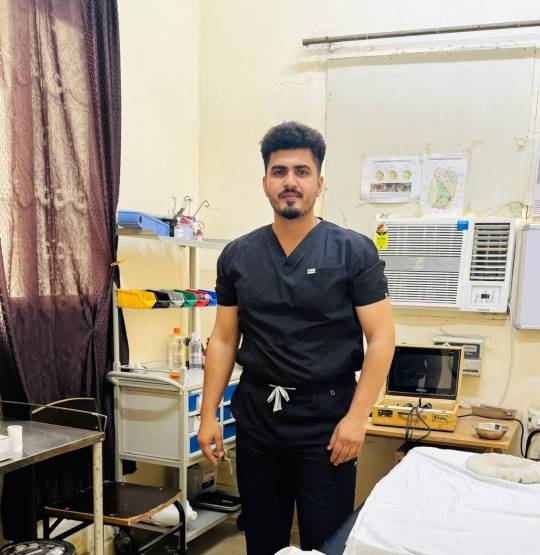
Dr. Paras Singh Jamwal, Jattashankar's friend. Photo provided by Paras.
Even though Jattashankar's family is far from the conflict, his friend and mentor at a university in India is witnessing a different reality.
Dr. Paras Singh Jamwal was born and raised in Jammu, Kashmir. Paras’ parents are safe after the recent air combat in their native region, but Paras remembers the phone conversation with them that night: the explosions were thunderous.
“Last night I was talking to my parents. Whole night sirens were blowing, and also the whole night there were all bombarding happening, so there was a lot of noise around my home”, Paras said after the recent battle between India and Pakistan.
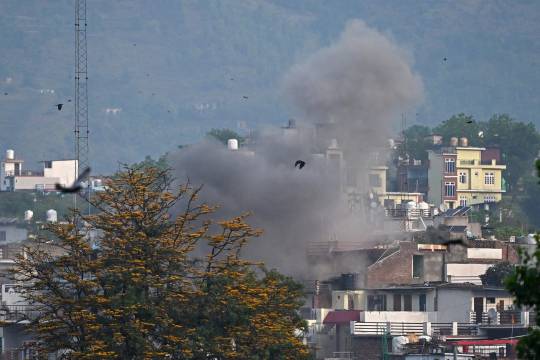
Smoke billows after an artillery shell landed in the main town of Poonch district in India's Jammu region on May 7, 2025. (Photo by PUNIT PARANJPE/AFP via Getty Images).
Kashmir and its citizens have long been prepared for a war scenario, and Paras said he witnessed several confrontations as a child.
“Growing up in a place where life was always under threat from terrorism was never easy. The constant fear became a part of everyday life…Those memories stay and they are not good for mental health,” said Paras.
As we talked to Jattashankar about today’s attacks, he said that Paras’ family who lives in Jammu is safe and okay.
It is not the first time in recent years that a full-scale war has loomed between the two nations. In 2019, a car packed with explosives rammed into a bus carrying Indian police officers, killing 40. In response, India launched an airstrike on a suspected militant camp in Pakistan, triggering a new wave of clashes.
“As for nuclear rhetoric, yes, I believe any normalization of nuclear threats, however subtle, is extremely dangerous. If powerful nations begin to use nuclear blackmail more openly, it sets a troubling precedent. It could embolden others to consider such tactics, which would erode global norms and increase the risk of catastrophic miscalculations,” said Jattashankar.
India has about 180 nuclear warheads in its stockpile, while it is estimated that Pakistan has approximately the same number. Neither of the countries have officially disclosed the number of nuclear weapons they possess.
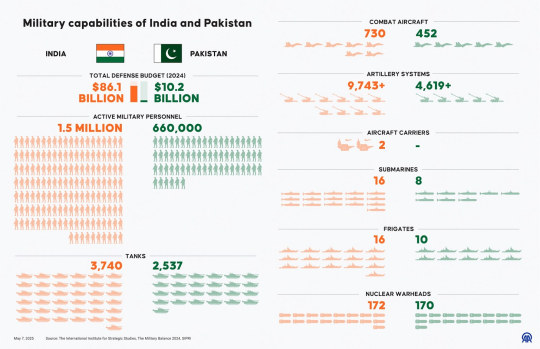
An infographic titled "Military capabilities of India and Pakistan" created in Ankara, Turkiye on May 7, 2025. (Photo by Yasin Demirci/Anadolu via Getty Images).
“My hopes for the future are that everything will settle down, because war is never a good thing…because in the end, people have to suffer,” said Paras, who plans to return to his native Jammu after completing his studies. “Let’s hope for humanity and let’s be human. Always.”
The world has entered a new stage of uncertainty, where large-scale war is no longer off the table. Since Russia’s illegal annexation of Crimea more than a decade ago, the costs of conflict seem to have been diminished.
And in a world where war is not deterred, one miscalculation can turn into a global conflagration.
In this time of great uncertainty — and unstable American support — it means that the situation on the ground is very dangerous. Your contributions help us get the body armor, medical gear, and supplies we need to stay safe.
Show your support by contributing to our tip jar - funds go towards keeping us safe and ensuring our work continues.
Tip Jar!
NEWS OF THE DAY:
INDIA AND PAKISTAN AGREE ON TRUCE: India and Pakistan have confirmed a ceasefire agreement following weeks of escalating clashes, missile exchanges, and drone strikes along their shared border over the long-disputed Kashmir region.
President Trump claimed that the U.S. was behind the ceasefire on his Truth Social platform Saturday. Although some diplomatic figures have mentioned that role played by the State Department, reporting is emerging that dozens of countries were involved — and that the deal ultimately came as a result of direct negotiations between the parties.
ALLIES PLAN SANCTIONS AGAINST RUSSIA: The U.S., the EU, and the U.K. are threatening additional sanctions against Russia if it refuses to accept a U.S.-led proposal for a 30-day ceasefire with Ukraine.
The warnings come as European leaders visit President Zelenskyy in Kyiv to demonstrate solidarity with Ukraine, after the leaders of China and Brazil traveled to Russia this week to attend Moscow’s Victory Day parade.
Ukraine has agreed to the proposed 30-day ceasefire, but President Putin has so far declined to support it. Kremlin press secretary Dmitry Peskov said Western delivery of arms to Ukraine should stop before agreeing to a ceasefire.
EU, UKRAINE ENDORSE WAR CRIMES TRIBUNAL: Ukraine and 35 European countries have endorsed the establishment of a special tribunal to prosecute Russia for its "crimes of aggression" against Ukraine.
“This means no one will escape accountability for the crimes committed—not even the [Russian] leaders who made the decision to send troops here to commit war crimes and atrocities we have witnessed,” said Kaja Kallas, the EU’s High Representative for Foreign Affairs.
The newly proposed tribunal would have the authority to pursue Russia over its decision to invade Ukraine, though it could only arrest Putin once he leaves office, due to the immunity granted to sitting presidents, prime ministers, and foreign ministers.
DOG OF WAR:
Today’s Dog of War is this doggie Nastia met in Ukraine’s western city of Chernivtsi, who was relaxing in a distinguished pose by the side of the street.

Stay safe out there.
Best, Clara
0 notes